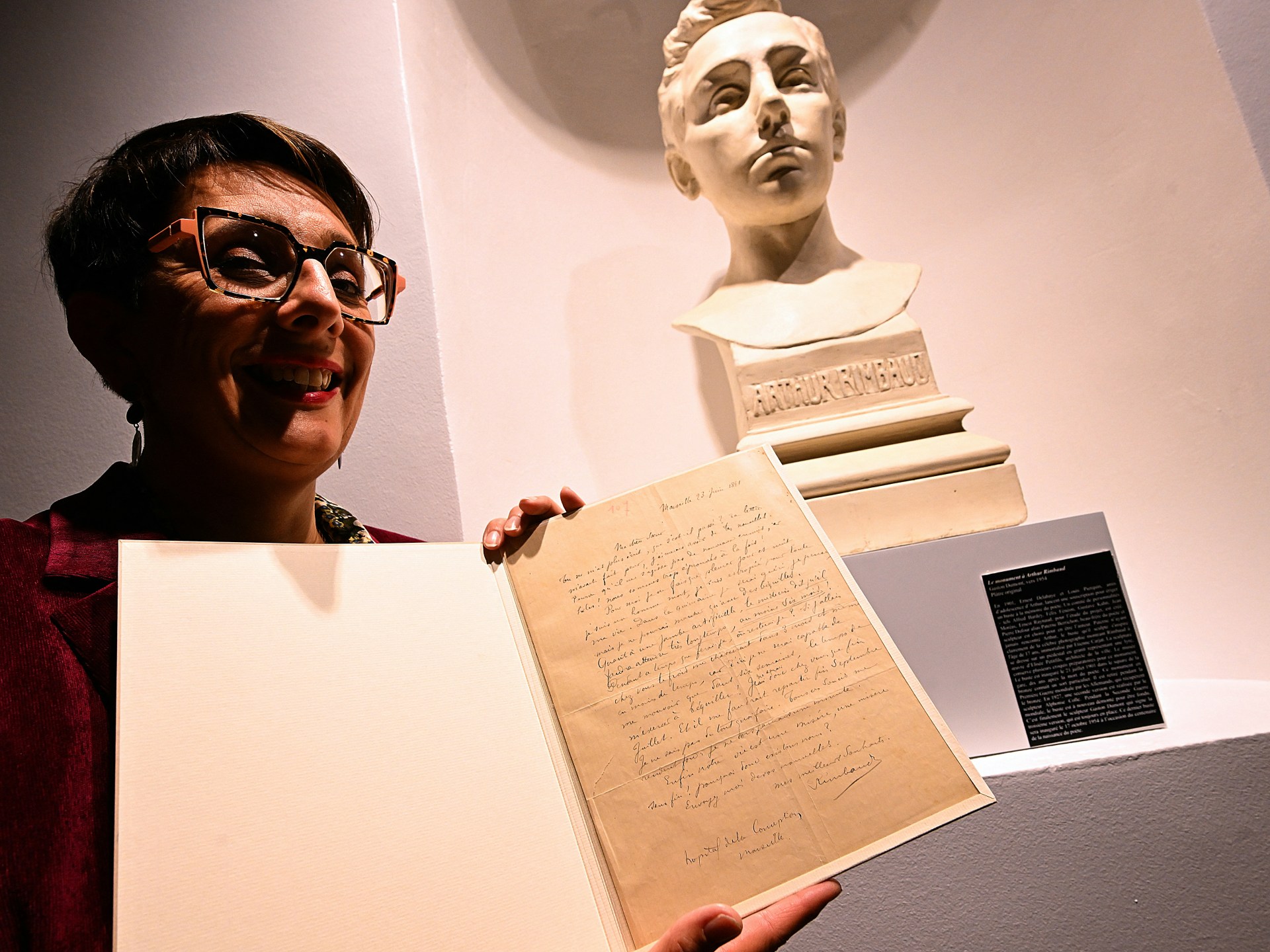Director of the Rimbaud Museum, Carole Marcoux-Morel, poses with a manuscript by French poet Arthur Rimbaud, in Charleville-Mézières (French)
The Arthur Rimbaud Museum in Charleville-Mézières (northeastern France) unveiled manuscripts of the poet that were recently purchased by a local industrialist for more than 240,000 euros, with the aim of donating them to the museum.
At a time when Rimbaud’s birthplace celebrates the 170th anniversary of the poet’s birth in October, these manuscripts were officially handed over to the museum during a ceremony held on Friday evening, before they are made available to the public from today, Saturday, until January 2025.
The manuscripts include two letters and two poems, which the industrialist bought during an auction held at the Drouot Hotel in Paris in December.
During this auction, the city municipality obtained, for 78 thousand euros, a third letter from Rimbaud in which he recounts the beginning of his illness.
But she was unable to obtain the manuscript of the poem “Immortality,” because its price reached 700 thousand euros.
Auction sponsor Pascal Orano told Agence France-Presse, "One of the letters is addressed to his mother and the second to his sister. He wrote one from Marseille when he was in the hospital, and the other from Africa."
The manuscripts include the poem “What Keeps Nina” by Rimbaud dated August 15, 1870, but it was reproduced by Paul Verlaine in 1880.
“Verlaine was madly in love with Rimbaud, and would go so far as to imitate his writings to ensure that the texts would not disappear,” museum director Carole Marquet-Morel told Agence France-Presse.
As for the three letters, all addressed to his family, “they relate to two different stages in his life.”
Manuscript of the French poet Arthur Rimbaud dating back to the 19th century (French)
The first, dated January 15, 1883, refers to “Rambo, who works for Alfred Pardee in Africa,” but it also shows “Rambo, who is passionate about photography and geography.”
The other two letters deal with his illness. “My legs are varicose,” he wrote on February 20, 1891. He “did not yet know that he had cancer,” Morrell said.
French poet and Yemeni merchant
In addition to his career as a poet, Rimbaud lived a short, turbulent life. In 1886, he led a trade caravan through Abyssinia, now known as Ethiopia. Although he was only 32 years old, his blond hair turned gray and his features became familiar in the region after years of poverty, suffering, and malnutrition. While his blue eyes remained as they were, evidence of his Frenchness hidden behind the shabby clothes, according to a previous report by Al Jazeera Net.
Rimbaud's early poems imitated the French literary school of Parnasse (a literary movement that appeared in the second half of the 19th century), whose rise coincided with his short life. It stressed that literature was an end in itself, and rejected it as a means of treating the concerns and issues of society.
In his book “The Seer’s Letters,” Rimbaud wrote in May 1871 (that is, when he was only 16 years old) two letters in which he explained his poetic philosophy, and said that the experience of writing poetry involves tremendous suffering, as the poet works to transform himself into a seer or spectator. He tries to reach the unknown by confusing all the senses and searching for himself in every form of love, suffering, and madness.
Arthur Rimbaud (1854-1891) stands in front of a tree in Harar, Ethiopia (Getty)
In his famous poem “The Drunken Boat,” he describes the drift and sinking of a boat lost at sea in a fragmented story filled with vivid images and symbols. The idea was inspired by the French novelist Jules Verne’s (1828-1905) novel “20 Thousand Leagues Under the Sea.”
Rambo settled in Aden, Yemen, in 1880, and succeeded in obtaining a job opportunity as a main employee in the Bardi Coffee Trading Company. He moved to Harar, Ethiopia, to continue working as an agent for the company there.
Rimbaud died on November 10, 1991 in Marseille.
Source: Al Jazeera + French

